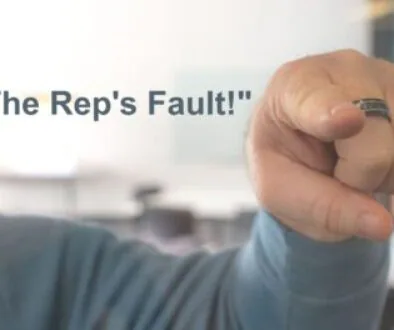A Strategy to Address the Price Issue in Medical Sales
“The materials manager called. She said I need to lower my price by 5% or she’s going to have to change vendors. Price is the only thing she cares about. She just doesn’t get it.”
Medical sales reps say that price is one of the biggest issues they face on an ongoing basis. No surprise there—healthcare has been increasingly price conscious for decades, and it’s becoming even more so as providers get squeezed on reimbursement.
As a medical sales professional, it’s important to shed any misperceptions you may have about pricing issues. You also need a proactive strategy for addressing the price issue moving forward.
1. Price is NOT what is most important to your customers.
I doubt that any of your customers entered healthcare with this goal: “To provide the cheapest care possible.” Price is a consideration, but it is not the most important one.
A clinician’s primary objective is to deliver the best possible patient outcomes while minimizing risk. Most medical sales representatives who read this are probably thinking, “Of course. I sell to address those needs.” In my experience, most sales reps sell to address what they think their customers need. Few dig deep enough to uncover a customer’s true needs, fears, and wants. When you do that better than your competition, and you sell a product that fulfills customer expectations, your price is secondary.
Reps complain that materials managers only care about price. Is getting the best price in a materials manager’s job description? Of course it is, but it isn’t their primary responsibility. The main role of a materials manager is to manage equipment and supplies in an efficient manner so everyone in the organization has what they need to do their jobs.
When the Emergency Department runs out of Foley catheters, they don’t call Materials and say, “I need a box of Foley catheters at the lowest price, stat!” The focus is getting what the patient needs. Likewise, when the purchasing agent calls a supplier with the urgent request, they are unlikely to be negotiating price at that moment. Why? Because price is secondary relative to the patient’s outcome.
2. When you allow customers to commoditize your product, then price becomes the only differentiator
Do you know all those cool features and benefits you talk about during your sales presentations? Well, your competitors who sell a similar product—their features and benefits are similar to yours; often, they’re the same. So, when you have two or more salespeople describing the same widget, what becomes the differentiator? Price!
Sales representatives often overestimate their sales abilities. They sell intuitively and fail to position their products effectively. When all you do is recite features and benefits, you’re not selling—you’re just a walking brochure. Only when your product is positioned for a specific challenge, need, or objective can it be differentiated. Most sales reps think they do this, but in the initial simulations during my live workshops, almost none do. By the end of the workshop, almost everyone is amazed at how much money they’ve been leaving on the table. Poor positioning skills are very expensive.
When customers see products as commodities, they naturally look to price as the differentiator. And it happens when sales representatives don’t do their jobs.
By the way, if your sales strategy is to be the lowest priced provider, good luck. That’s a business model that is seldom sustainable. There will always be a competitor who is willing to go out of business faster than you.
3. The decision makers and influencers in your accounts, who don’t know you, can’t support you.
Medical sales reps are well-known for calling on product end-users while ignoring any other stakeholders until there’s an issue or a committee meeting. If the words “account penetration” are only used in discussions with your sales manager, it’s time to start doing it. Effective account penetration provides a competitive advantage when you do it better and more consistently than your competition. The key is in calling on every potential influencer on a regular basis, and positioning your products and supporting services specifically for each of them.
Those end-users you’ve been calling on for months or years—turn them into champions and coaches. Ask them who you need on your side to support the use, or the continued use of your product. They can help familiarize you with many of the key concerns you’ll need to address with people who sit on committees or influence product decisions in other ways. Ask end-users if they can voice their support for your product to the right people. Don’t hesitate to ask if they can help you to get in to see the people you should be talking to.
The Price Issue is You
Welcome to the era of Value Based Purchasing (VBP). Yes, lowering costs is a priority, but so are improving quality and patient satisfaction. This can’t be accomplished with the cheapest product or service alone. Make sure your customers are meeting the benchmarks for VBP that impact their reimbursement. Don’t relax when things are quiet on the pricing front in your accounts. It won’t stay that way. If your customers are paying more for your product than what they can get from a competitor, you must continually differentiate the value they’re getting in return. Consider each stakeholder’s primary need as it relates to your product. Make sure they’re clear as to what’s in it for them. And since everyone knows that sales is a relationship business, develop and sustain relationships with everyone who has a say in buying from you.
When a customer believes that the only differentiator for your product is price, it’s your fault.
Would you like to know 10 ways of effectively handling medical sales price objections? Get Mace’s FREE one page resource sheet by clicking the button in the box below.




@ 10:05 am
What else can medical sales professionals do to proactively address pricing issues?
@ 6:35 am
Once again I completely agree with your thoughts. As an example we can look at the kit builders in the medical industry. It is obvious that Hospitals and surgery centers can purchase the items in kits cheaper if they were to source the items separately, yet most purchase kits for many of there procedures. Why? The kit builders have done an excellent job of understanding the facilities needs in maintain minimal inventory levels, lower FTEs and user preferred products. individual competitors often sell their products either on FAB or price. We should all wake up and learn the customers true needs and desires.
@ 1:04 pm
Rich, thanks for your spot on comment. Many reps talk about learning the cusomer’s needs, but few actually take the time because they’re too busy spewing features benefits. Don’t you just love competing against sales organizations that do that?
@ 4:26 am
Very informative post.
Would you apply the same tactics to the cosmetic surgery field? I would like to know your thoughts on addressing the price issue in a unique way. Strategize around convincing the surgeon to slightly increase the surgery price (no insurance covers cosmetic surgeries) and pass the additional cost onto the patients (moderate to high income), it would be a win win.